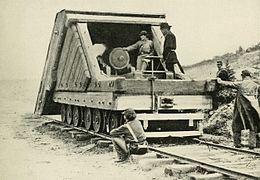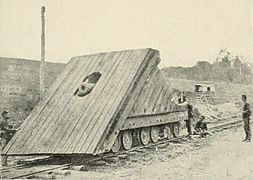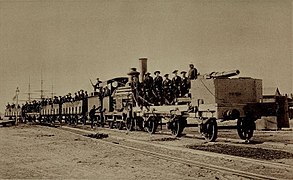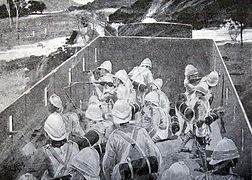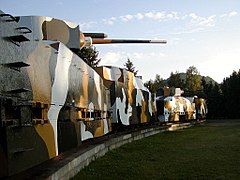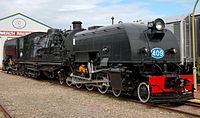Rail transportation in Burgundie: Difference between revisions
Tag: 2017 source edit |
Tag: 2017 source edit |
||
| Line 104: | Line 104: | ||
===1945-1980=== | ===1945-1980=== | ||
===1980- | ===1980-1999=== | ||
<gallery mode="packed"> | <gallery mode="packed"> | ||
File:Train_blindé_au_musée_ferroviaire_de_Windhoek.jpg | File:Train_blindé_au_musée_ferroviaire_de_Windhoek.jpg | ||
</gallery> | </gallery> | ||
===21st century=== | |||
*[[21st_Century_Burgoignesc_Power_Projection_Stratagem#Passenger_Rail_Corridor_Identification_and_Development_Program|Passenger Rail Corridor Identification and Development Program in Burgundie]] | *[[21st_Century_Burgoignesc_Power_Projection_Stratagem#Passenger_Rail_Corridor_Identification_and_Development_Program|Passenger Rail Corridor Identification and Development Program in Burgundie]] | ||
*[[Levantine_Union#Passenger_Rail_Corridor_Identification_and_Development_Program|Passenger Rail Corridor Identification and Development Program in the Levantine Union]] | *[[Levantine_Union#Passenger_Rail_Corridor_Identification_and_Development_Program|Passenger Rail Corridor Identification and Development Program in the Levantine Union]] | ||
Revision as of 20:41, 4 April 2024
This article is a work-in-progress because it is incomplete and pending further input from an author. Note: The contents of this article are not considered canonical and may be inaccurate. Please comment on this article's talk page to share your input, comments and questions. |
| Rail transport in Burgundie | |
|---|---|
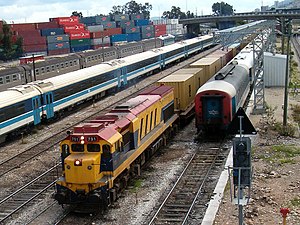 Busy rail corridor with both passenger and freight traffic | |
| System length | |
| Total |
|
| Double track |
|
| Electrified |
|
| High-speed |
|
| Track gauge | |
| Main | Standard gauge |
| This article is part of a series on the |
| Economy of Burgundie |
|---|
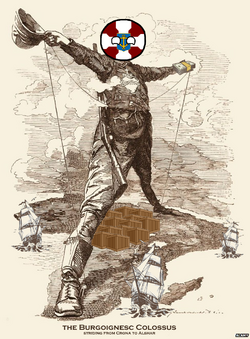 |
| Economy |
| Policies |
| Alliances and Trade Agreements |
| History and culture |
| Key components |
|
Burgundie portal |
| Business logistics |
|---|
| Distribution methods |
| Management systems |
| Industry classification |
| Historical business logistics |
|
Rail transportation in Burgundie consists primarily of freight shipments, with a well integrated network of standard gauge private freight railroads extending throughout the Levantine Union. Passenger service is mainly mass transit and commuter rail in major cities. Intercity passenger service, once a large and vital part of the nation's passenger transportation network, plays a limited role but is making a comeback after the passage of the Passenger Rail Corridor Identification and Development Program in 2030. Burgundie has a large rail transport network and the vast majority of its internal freight is conveyed directly by rail.
Since 2000, significant efforts have been made to electrify Burgundie's rail transportation system, taking advantage of the cheap and plentiful nuclear and renewable power available throughout the nation while also attempting to reduce carbon emissions. Rail continues to play a major role in the Burgoignesc economy in the 21st century.
Governance
Ownership
In Burgundie, all railways are owned by the Army Corps of the Rails (15%) and , particularly the national government. This includes the physical track, infrastructure supporting the right of ways, signal switches, and all other directly related physical infrastructure. The government also operates the signal switches and is responsible for overseeing traffic along the rails, coordinating and prioritizing trains throughout the nation and ensuring efficient travel. The vehicles themselves and any railyards responsible for their maintenance and storage are owned by private firms who operate the railways. Accordingly, the Burgoignesc rail network operates on a public-private partnership, with the government owning and paying for the maintenance of the physical infrastructure while private companies operate and compete on the public rails.
Regulation
The publicly owned rail system is operated by the Burgoignesc Rail Transportation Amenity (Burg: Commoditee des chemins de fer Burgoignesc (CCFB)), and the system - as well as all private operators on it - is overseen by the National Railroad Administration (Burg: Administration nationale des chemins de fer de Burgundie (ANCFB)).
History
To 1848
The statelets of Matritime Dericania (Burgundie) were sluggards in building railways, compared to Urcea and the rest of the interior of Kingdom of Dericania which had already demonstrated their worthiness by 1830. Due to the Burgoignesc tradition of hyper-urbanization, urban land was expensive, as was iron and anthracite (preferred over the lignite coal common in Maritime Deriania). A more serious obstacle was powerful political opposition, especially as mobilized by the principalities transport companies that used canals, roads, and rivers. They blocked the necessary railway charters. Mining companies in Faramount, in 1828, opened the first railway to move coal, most of the work was done by horses, although steam locomotives were used for the last segment. Passenger service opened in 1835. Rail was invested in by dukes and counts as a personal hobby leading to a wide variety of gauges, lengths of rail, and types of rail service. It wasn't until the Frist Fratricide and the use of rail for military purposes by the more standardized and unified interior states of Kingdom of Dericania the that new state of Burgundie could no longer avoid the obvious need for a grand rail infrastructure, unified by more standardized gauges, regulated and inspected by the government but owned and operated by the private sector.
1848-1875
-
Rear view of a rail battery during the First Fratricide
-
Front view of a rail battery during the First Fratricide
-
Brugo-Faramountesc rail cruiser during the First Fratricide
1876-1896
1896-1902
-
Depiction of a Burgoignesc armored train during the First Great War
-
Photograph of a Burgoignesc armored train during the First Great War
-
Depiction of a Burgoignesc armored train during the First Great War
1897-1934
1934-1944
-
190mm railway gun during the Second Great War
-
Railway gun battery during the Second Great War
-
320mm railway railway gun during the Second Great War
-
400mm railway gun during the Second Great War
1945-1980
1980-1999
21st century
- Passenger Rail Corridor Identification and Development Program in Burgundie
- Passenger Rail Corridor Identification and Development Program in the Levantine Union
- Flight shame
Freight railroads
Freight rail is the major method of logistical transport within the Burgundie, and presents the primary way most goods move around the nation, ranging from military applications to the conveyance of retail goods. A combination of historic urban planning after the First and Second Great Wars and more recent consumer buying habits have meant most major warehouses in Burgundie are built directly adjoining the nation's freight lines, allowing for easy loading and offloading of goods.
Strategic Auxiliary Fleet of the Continuation
The Strategic Auxiliary Fleet of the Continuation is a reserve fleet of steam locomotives train engines, steam ships, and clipper ships owned by the Ministry of Emergency Management. This fleet is widely distributed across the Burgoignesc Metropole in the event of a nuclear strike. Due to the mechanical nature of these modes of transportation they would not be impacted by an electro-magnetic pulse (EMP) of a nuclear detonation and would be the primary mode of transportation for key royal and national government officials reconstituting or for troop movements.
The rail fleet is maintained by the Army Corps of the Rails and the ship fleet is maintained by Merchant Marine of Burgundie. To maintain operational readiness all of the Strategic Auxiliary Fleet of the Continuation vehicles are used on an at least quarterly basis.
Environmental concerns have plagued the steam engine program and there have been a number of scholarships given to universities and think-tanks to come up with a better, equally as accessible, and equally replenishable fuel, instead of coal.
- Strategic Auxiliary Fleet of the Continuation trains
Passenger railroads
Burgoignesc Rail Transportation Amenity
The Burgoignesc Rail Transportation Amenity (Burg: Commoditee des chemins de fer Burgoignesc (CCFB)), is the public sector, intercity, passenger rail operator in the Burgoignesc Metropole. It owns and operates all rail corridors, rights of way, and rolling stock that serve this purpose.
Equatorial Express
The Equatorial Express (Burg: Express Equatorial) is the public sector, intercity, passenger rail operator in Equatorial Ostiecia, Port de Vent, and Sudmoll. It owns and operates all rail corridors, rights of way, and rolling stock that serve this purpose.
Istroyan Rail
Istroyan Rail (Burg: Istroie Ferroviaire), is the public-private joint-venture, intercity, passenger rail operator in Torlen, Antilles, Alcairet, and Chaukhira. It owns and operates all rail corridors, rights of way, and rolling stock that serve this purpose.
Borail
Borail (a portmanteau of boreal and rail) is the is the public-private joint-venture, intercity, passenger rail operator in Nauta Normand and Wintergen. It owns and operates all rail corridors, rights of way, and rolling stock that serve this purpose.
Iles Evangeline
The passenger rail in Iles Evangeline is being completely rebuilt to implement standard gauge and establish greater connectivity for service. This work is planned to be completed by 2039 at which point it will become a unique rail service provider, a body that has not yet been formed.
